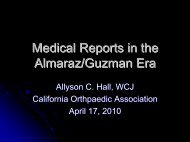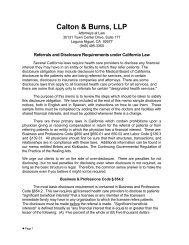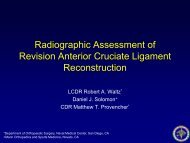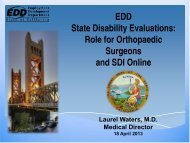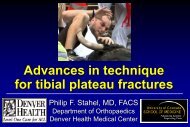Enhancing Your Practice's Revenue - California Orthopaedic ...
Enhancing Your Practice's Revenue - California Orthopaedic ...
Enhancing Your Practice's Revenue - California Orthopaedic ...
- No tags were found...
You also want an ePaper? Increase the reach of your titles
YUMPU automatically turns print PDFs into web optimized ePapers that Google loves.
• If there are 2,080 working hours in a year (eight hoursa day, five days a week, 52 weeks a year), and youroverhead is $350,000 per physician per year, then thecost of keeping your office open is $168 per hour. Again,you should calculate what the cost is for you in yourparticular office on at least an annual basis.• If the surgeons in your practice want to net $500,000per year ($240 per hour assuming 2,080 hours), thenthe minimum revenue you must receive per hour muston average be $240 plus $168 or $408. You can consultfee schedules for payers and workers’ compensation to seeif this is feasible. Remember that ancillary income (X-ray,PT/OT, DME, casting, neutraceuticals, etc.) all add to thevalue of the patient encounter.MarketingAppropriate marketing of the UCC has the potential ofdriving even more patients into the practice. The centerneeds to attract a population of patients that otherwisewould have gone to the ER. Since the average ER cost(excluding physician fees) in 2008 was $956 per patientvisit, the use of an after-hours UCC is very much a costcutting measure for the community. That said, yourmarketing should not suggest that the UCC is simply analternative to the ER. Instead, it should emphasize thatthe UCC offers after-hours services that overcrowded andbusy ERs – with the best will in the world – simply cannotprovide. This approach will hopefully aid in communityacceptance and minimize any hospital-clinic hostility.Marketing should be directed to patients, payers andreferral sources alike. Gaining the support of referringdoctors in particular is paramount to achieving success.The Last Word from this DoctorThe development of an <strong>Orthopaedic</strong> UCC or afterhoursclinic will allow orthopaedic practices to grow andgenerate additional revenue; it will also serve to position thepractice for the evolving world of hospital/practice/payerconsolidation that appears to be the future of health care.Specifically, the combination of accessible, affordable, andhigh-quality care offered by a well-run UCC will be key tomaking the center attractive to payers and hospitals alike,especially in the upcoming development of AccountableCare Organizations (See the ACO companion Primerdeveloped by the Health Care Systems Committee). Thekeys to UCC success lie in effective planning, positioning,and above all staff and physician buy-in to the concept that“what is good for patients will be good for the practice.”Contact: Thomas Grogan, MD: tjgrogan@aol.comChapter 5Ambulatory Surgery CentersBy Douglas Turgeon, MDManaged care penetration is increasing. Medicare rates aredrifting downward and these decreases are often mirroredby private payers. Total costs of doing business are not onlyrising but some that were previously paid by others arenow being shifted to physicians. As orthopaedic surgeons,we are therefore forced to search for ways to maintain ourpractices’ financial viability while at the same time meetingthe healthcare needs of a growing and aging patientpopulation.Investment and participation in ambulatory surgerycenters (ASCs) – either directly by a physician practice orgroup or indirectly via a joint venture with a hospital or ahealth care management company – has become a means toaddress orthopaedists’ monetary concerns, and to directlyand positively influence patient care delivery.The enormous complexity of the ASC industry makesany overview a daunting task, and an exhaustive coverageof the topic is beyond the scope of this Primer. However,I hope this chapter will touch on many of the major issuesthat orthopaedists might consider in connection withASCs, including:• The importance of planning• Go it alone vs. partner with a third party• Physical facility location and design• Staffing considerations• Financial matters• Compliance with regulationsDevelopment of an ambulatory surgery center is nota strategy that will work for every orthopaedic surgeon.However, the number of ASCs nationwide has increaseddramatically over the past decade. ASCs have been widelyrecognized for their efficiency and improved patient safety.They also add healthy competition to the healthcare marketplaceeven though they must adhere to the same protocolsas hospitals. Physician owners of ASCs are universallyproud of their ability to provide high-quality patient care ina cost-effective setting.The Importance of PlanningThe success of any business, and this includes anASC, depends first and foremost on planning; that is,identifying the activities that need to be undertaken fromstart to finish. The plan should also identify who will beundertaking each activity and what the deadlines are forcompletion. The $64,000 question though is who should18© 2011 American Academy of <strong>Orthopaedic</strong> Surgeons




